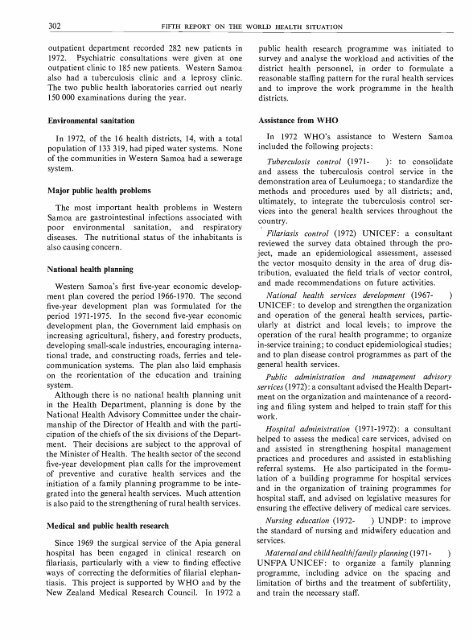FIFTH REPORT - World Health Organization
FIFTH REPORT - World Health Organization
FIFTH REPORT - World Health Organization
You also want an ePaper? Increase the reach of your titles
YUMPU automatically turns print PDFs into web optimized ePapers that Google loves.
302 <strong>FIFTH</strong> <strong>REPORT</strong> ON THE WORLD HEALTH SITUATION<br />
outpatient department recorded 282 new patients in<br />
1972. Psychiatric consultations were given at one<br />
outpatient clinic to 185 new patients. Western Samoa<br />
also had a tuberculosis clinic and a leprosy clinic.<br />
The two public health laboratories carried out nearly<br />
150 000 examinations during the year.<br />
Environmental sanitation<br />
In 1972, of the 16 health districts, 14, with a total<br />
population of 133 319, had piped water systems. None<br />
of the communities in Western Samoa had a sewerage<br />
system.<br />
Major public health problems<br />
The most important health problems in Western<br />
Samoa are gastrointestinal infections associated with<br />
poor environmental sanitation, and respiratory<br />
diseases. The nutritional status of the inhabitants is<br />
also causing concern.<br />
National health planning<br />
Western Samoa's first five -year economic development<br />
plan covered the period 1966 -1970. The second<br />
five -year development plan was formulated for the<br />
period 1971 -1975. In the second five -year economic<br />
development plan, the Government laid emphasis on<br />
increasing agricultural, fishery, and forestry products,<br />
developing small -scale industries, encouraging international<br />
trade, and constructing roads, ferries and telecommunication<br />
systems. The plan also laid emphasis<br />
on the reorientation of the education and training<br />
system.<br />
Although there is no national health planning unit<br />
in the <strong>Health</strong> Department, planning is done by the<br />
National <strong>Health</strong> Advisory Committee under the chairmanship<br />
of the Director of <strong>Health</strong> and with the participation<br />
of the chiefs of the six divisions of the Department.<br />
Their decisions are subject to the approval of<br />
the Minister of <strong>Health</strong>. The health sector of the second<br />
five -year development plan calls for the improvement<br />
of preventive and curative health services and the<br />
initiation of a family planning programme to be integrated<br />
into the general health services. Much attention<br />
is also paid to the strengthening of rural health services.<br />
Medical and public health research<br />
Since 1969 the surgical service of the Apia general<br />
hospital has been engaged in clinical research on<br />
filariasis, particularly with a view to finding effective<br />
ways of correcting the deformities of filarial elephantiasis.<br />
This project is supported by WHO and by the<br />
New Zealand Medical Research Council. In 1972 a<br />
public health research programme was initiated to<br />
survey and analyse the workload and activities of the<br />
district health personnel, in order to formulate a<br />
reasonable staffing pattern for the rural health services<br />
and to improve the work programme in the health<br />
districts.<br />
Assistance from WHO<br />
In 1972 WHO's assistance to Western Samoa<br />
included the following projects:<br />
Tuberculosis control (1971- ): to consolidate<br />
and assess the tuberculosis control service in the<br />
demonstration area of Leulumoega; to standardize the<br />
methods and procedures used by all districts; and,<br />
ultimately, to integrate the tuberculosis control services<br />
into the general health services throughout the<br />
country.<br />
Filariasis control (1972) UNICEF: a consultant<br />
reviewed the survey data obtained through the project,<br />
made an epidemiological assessment, assessed<br />
the vector mosquito density in the area of drug distribution,<br />
evaluated the field trials of vector control,<br />
and made recommendations on future activities.<br />
National health services development (1967- )<br />
UNICEF: to develop and strengthen the organization<br />
and operation of the general health services, particularly<br />
at district and local levels; to improve the<br />
operation of the rural health programme; to organize<br />
in- service training; to conduct epidemiological studies;<br />
and to plan disease control programmes as part of the<br />
general health services.<br />
Public administration and management advisory<br />
services (1972): a consultant advised the <strong>Health</strong> Department<br />
on the organization and maintenance of a recording<br />
and filing system and helped to train staff for this<br />
work.<br />
Hospital administration (1971- 1972): a consultant<br />
helped to assess the medical care services, advised on<br />
and assisted in strengthening hospital management<br />
practices and procedures and assisted in establishing<br />
referral systems. He also participated in the formulation<br />
of a building programme for hospital services<br />
and in the organization of training programmes for<br />
hospital staff, and advised on legislative measures for<br />
ensuring the effective delivery of medical care services.<br />
Nursing education (1972- ) UNDP: to improve<br />
the standard of nursing and midwifery education and<br />
services.<br />
Maternal and child health /family planning (1971- )<br />
UNFPA UNICEF: to organize a family planning<br />
programme, including advice on the spacing and<br />
limitation of births and the treatment of subfertility,<br />
and train the necessary staff.
















